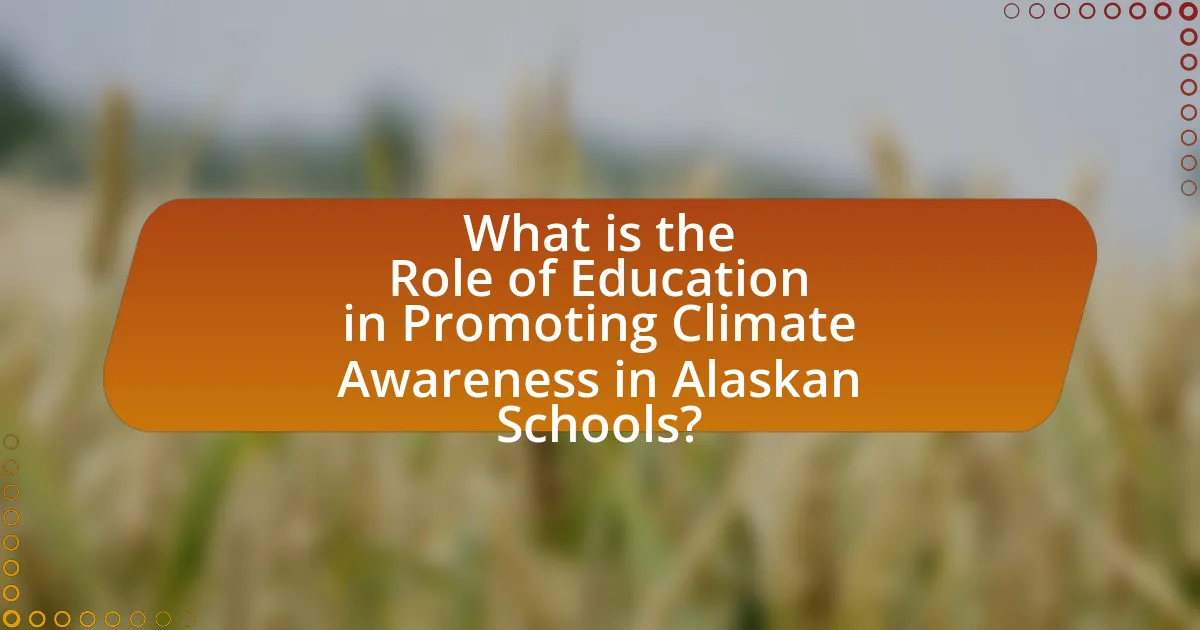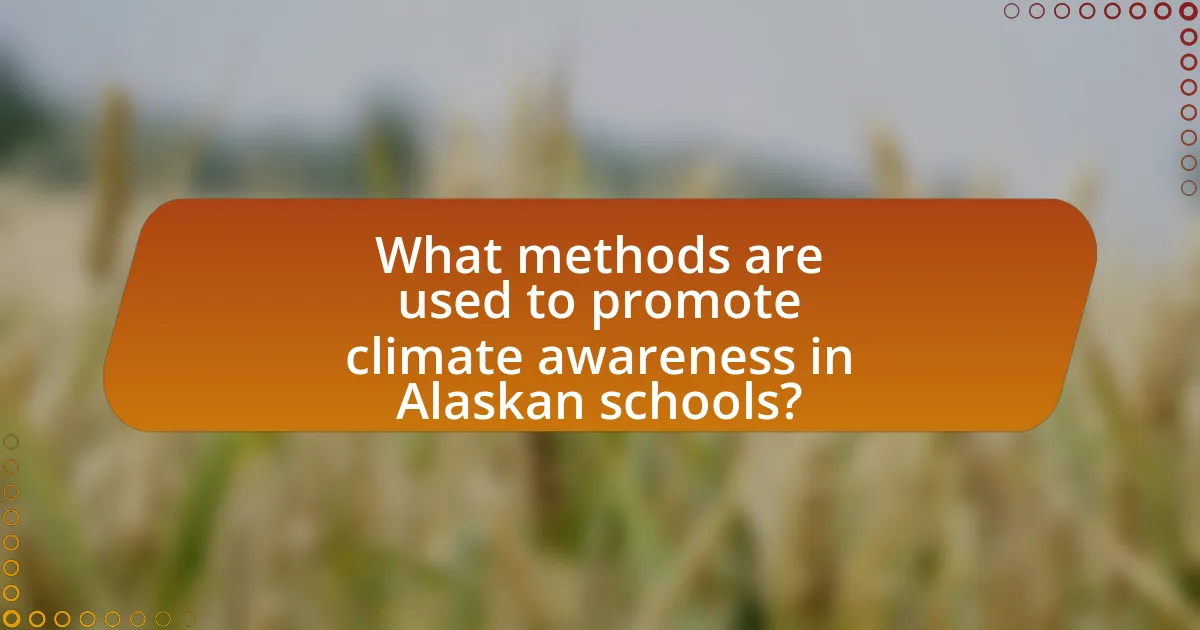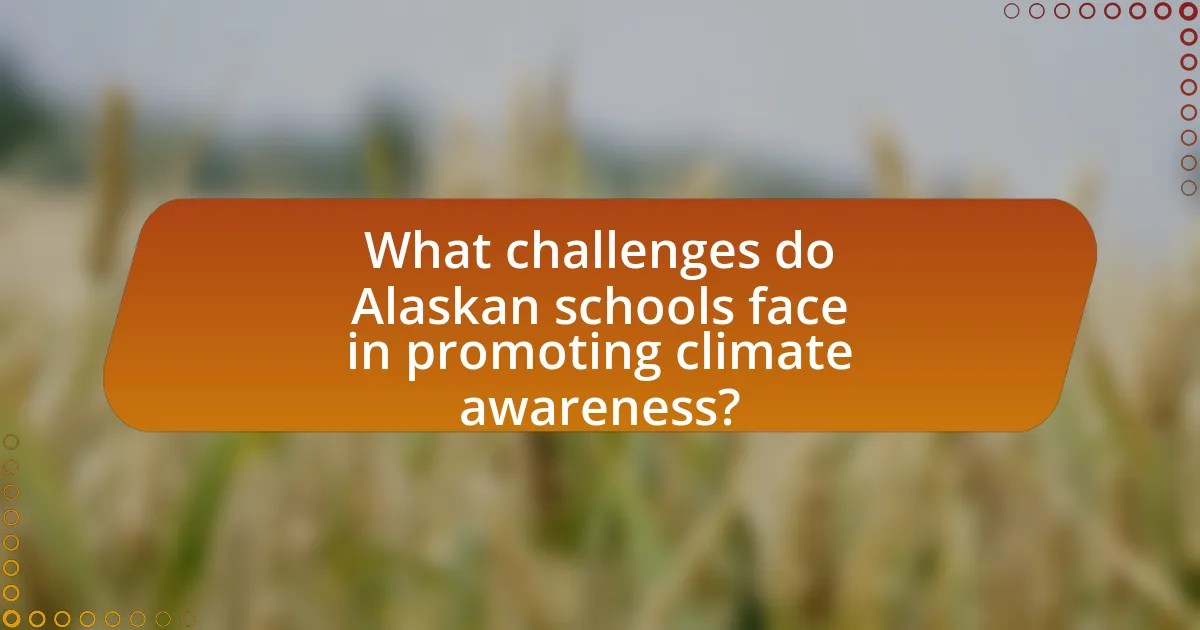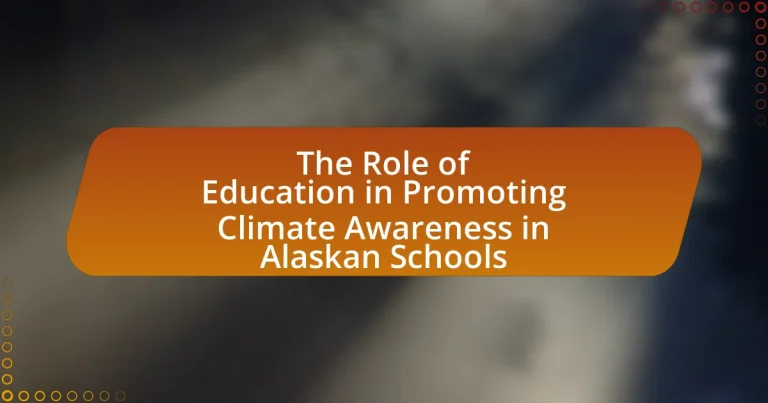The article examines the critical role of education in promoting climate awareness within Alaskan schools. It highlights how integrating environmental science into the curriculum fosters stewardship among students and enhances their understanding of local climate challenges, such as melting permafrost and changing wildlife patterns. The article discusses various educational frameworks, hands-on learning experiences, and community partnerships that support climate education, while also addressing the unique climate challenges Alaska faces. Additionally, it explores the importance of teacher training, student-led initiatives, and strategies for overcoming barriers to effective climate education, ultimately emphasizing the need for informed citizens capable of addressing climate change impacts in their communities.

What is the Role of Education in Promoting Climate Awareness in Alaskan Schools?
Education plays a crucial role in promoting climate awareness in Alaskan schools by integrating environmental science into the curriculum and fostering a sense of stewardship among students. This approach equips students with knowledge about the unique climate challenges faced by Alaska, such as melting permafrost and changing wildlife patterns. Research indicates that educational programs focused on climate change can significantly enhance students’ understanding and engagement, as seen in initiatives like the Alaska Climate Adaptation Science Center, which provides resources for teachers to incorporate climate education effectively. By emphasizing local environmental issues, Alaskan schools can cultivate informed citizens who are prepared to address climate change impacts in their communities.
How does education influence climate awareness among students in Alaska?
Education significantly enhances climate awareness among students in Alaska by integrating local environmental issues into the curriculum. This approach fosters a deeper understanding of climate change impacts specific to the Alaskan ecosystem, such as melting permafrost and changing wildlife patterns. Research conducted by the University of Alaska Fairbanks indicates that students exposed to climate education demonstrate increased knowledge and concern about environmental issues, leading to proactive behaviors in their communities. Furthermore, hands-on learning experiences, such as field studies and community projects, reinforce the relevance of climate science, making students more engaged and informed advocates for sustainability.
What educational frameworks are used to teach climate awareness in Alaskan schools?
Alaskan schools utilize the Alaska Science Standards and culturally relevant pedagogy to teach climate awareness. The Alaska Science Standards emphasize understanding climate systems, ecosystems, and human impacts on the environment, aligning with the Next Generation Science Standards. Additionally, culturally relevant pedagogy incorporates Indigenous knowledge and perspectives, fostering a connection between students and their local environment. This approach is supported by research indicating that integrating local ecological knowledge enhances student engagement and understanding of climate issues.
How do local environmental issues shape the curriculum in Alaskan education?
Local environmental issues significantly shape the curriculum in Alaskan education by integrating place-based learning that emphasizes the unique ecological challenges and cultural contexts of the region. For instance, schools often incorporate topics such as climate change, wildlife conservation, and sustainable practices into their lessons, reflecting the immediate environmental concerns faced by Alaskan communities. This approach is supported by educational frameworks like the Alaska Standards for Culturally Responsive Schools, which encourage the inclusion of local knowledge and environmental stewardship in teaching. Additionally, programs like the Alaska Native Science and Engineering Program (ANSEP) promote hands-on learning experiences that connect students with their local ecosystems, fostering a deeper understanding of environmental issues and their implications for the community.
Why is climate awareness important for students in Alaska?
Climate awareness is crucial for students in Alaska because they are directly affected by the impacts of climate change, such as rising temperatures, melting ice, and changing ecosystems. These environmental changes threaten traditional livelihoods, including subsistence hunting and fishing, which are vital to Alaskan culture and economy. For instance, the Arctic is warming at twice the global average, leading to significant alterations in wildlife patterns and habitat loss. Educating students about climate issues empowers them to understand these challenges and fosters a sense of responsibility to advocate for sustainable practices and policies that can mitigate these effects.
What unique climate challenges does Alaska face that necessitate education on this topic?
Alaska faces unique climate challenges such as rapid warming, increased coastal erosion, and permafrost thawing, which necessitate education on these topics. The state is experiencing temperature increases at twice the global average, leading to significant ecological and infrastructural impacts. For instance, the Arctic is warming at a rate of approximately 3 degrees Fahrenheit per decade, resulting in the destabilization of permafrost, which affects buildings and roads. Additionally, coastal communities are facing erosion rates of up to 20 feet per year, threatening homes and livelihoods. These challenges highlight the urgent need for educational initiatives that equip students with knowledge about climate change and its local effects, fostering a generation capable of addressing these pressing issues.
How does climate awareness impact the future of Alaskan communities?
Climate awareness significantly impacts the future of Alaskan communities by fostering adaptive strategies to combat climate change effects. Increased awareness leads to informed decision-making regarding resource management, infrastructure development, and community resilience. For instance, the Alaska Climate Change Impact Assessment highlights that understanding climate patterns enables communities to prepare for rising sea levels and permafrost thawing, which threaten local ecosystems and livelihoods. Furthermore, educational initiatives in schools promote climate literacy, empowering younger generations to engage in sustainable practices and advocate for policies that mitigate climate risks. This proactive approach is essential for the long-term viability of Alaskan communities facing environmental challenges.

What methods are used to promote climate awareness in Alaskan schools?
Alaskan schools promote climate awareness through various methods, including integrating climate education into the curriculum, engaging students in hands-on environmental projects, and utilizing local resources and indigenous knowledge. For instance, the Alaska Department of Education and Early Development supports programs that incorporate climate science into subjects like science and social studies, ensuring students understand the local impacts of climate change. Additionally, initiatives such as the Alaska Climate Adaptation Science Center provide resources and training for educators to effectively teach climate-related topics, fostering a deeper understanding among students. These methods are validated by the increasing emphasis on environmental education in state educational standards and the involvement of local communities in climate action initiatives.
What types of programs are implemented to enhance climate education?
Various programs are implemented to enhance climate education, including hands-on environmental science curricula, community-based projects, and partnerships with local organizations. These programs often focus on experiential learning, allowing students to engage directly with their environment, such as through field studies and conservation efforts. For instance, the Alaska Department of Education and Early Development promotes initiatives like the Alaska Climate Adaptation Science Center, which provides resources and training for educators to integrate climate science into their teaching. Additionally, programs like the “Climate Change Education Partnership” aim to develop educational materials that are culturally relevant and scientifically accurate, ensuring that students understand the local impacts of climate change.
How do hands-on activities and field trips contribute to climate learning?
Hands-on activities and field trips significantly enhance climate learning by providing experiential learning opportunities that engage students directly with their environment. These methods allow students to observe climate phenomena, collect data, and participate in real-world problem-solving, which deepens their understanding of climate concepts. Research indicates that experiential learning can improve retention of information and foster critical thinking skills, essential for addressing climate issues. For instance, a study by the National Oceanic and Atmospheric Administration found that students who participated in field-based learning showed a 30% increase in their understanding of climate science compared to traditional classroom instruction. This evidence underscores the effectiveness of hands-on activities and field trips in promoting climate awareness and education.
What role do partnerships with local organizations play in climate education?
Partnerships with local organizations play a crucial role in climate education by providing resources, expertise, and community engagement that enhance learning experiences. These collaborations enable schools to access local knowledge about environmental issues, fostering a deeper understanding of climate impacts specific to Alaska. For instance, organizations like the Alaska Center for the Environment offer educational programs that align with state standards, ensuring that students receive relevant and practical information. Additionally, partnerships facilitate hands-on learning opportunities, such as field trips and workshops, which have been shown to increase student interest and retention in climate-related subjects.
How are teachers trained to deliver climate education effectively?
Teachers are trained to deliver climate education effectively through specialized professional development programs that focus on climate science, pedagogy, and local environmental issues. These programs often include workshops, online courses, and collaborative projects that equip educators with the necessary knowledge and teaching strategies to engage students in climate-related topics. For instance, the Alaska Department of Education and Early Development provides resources and training that emphasize culturally relevant teaching methods and the integration of Indigenous knowledge, which is crucial for addressing climate change impacts in Alaskan communities.
What professional development opportunities exist for educators in Alaska?
Professional development opportunities for educators in Alaska include workshops, online courses, and conferences focused on climate education and environmental science. Organizations such as the Alaska Department of Education and Early Development and the Alaska Environmental Education Association offer resources and training specifically aimed at enhancing educators’ knowledge and skills in teaching climate awareness. Additionally, the University of Alaska provides graduate programs and continuing education courses that emphasize sustainability and environmental stewardship, which are crucial for integrating climate topics into the curriculum. These opportunities are designed to equip educators with the necessary tools to effectively teach students about climate change and its impacts on the Alaskan environment.
How does teacher engagement influence student learning about climate issues?
Teacher engagement significantly enhances student learning about climate issues by fostering a more interactive and supportive learning environment. Engaged teachers utilize diverse teaching methods, such as hands-on activities and discussions, which promote critical thinking and deeper understanding of climate concepts. Research indicates that when teachers actively participate in professional development related to climate education, they are better equipped to convey complex topics effectively, leading to improved student outcomes. For instance, a study by the National Oceanic and Atmospheric Administration found that students taught by engaged teachers demonstrated a 30% increase in knowledge retention regarding climate science compared to those with less engaged educators. This evidence underscores the critical role that teacher engagement plays in shaping students’ awareness and understanding of climate issues.

What challenges do Alaskan schools face in promoting climate awareness?
Alaskan schools face significant challenges in promoting climate awareness, primarily due to geographic isolation and limited resources. The vast distances between communities hinder collaboration and access to educational materials, making it difficult for schools to implement comprehensive climate education programs. Additionally, many schools operate with constrained budgets, which restricts their ability to invest in training teachers or acquiring updated resources on climate science. Furthermore, the cultural context in Alaska, where traditional practices and local knowledge may not align with formal climate education, poses another barrier to effectively engaging students in climate issues.
What barriers exist in implementing climate education in the classroom?
Barriers in implementing climate education in the classroom include a lack of resources, insufficient teacher training, and curriculum constraints. Many schools in Alaska face budget limitations that hinder the acquisition of educational materials and technology necessary for effective climate education. Additionally, teachers often lack specialized training in climate science, which can lead to a gap in knowledge and confidence when teaching the subject. Furthermore, existing curricula may not prioritize climate education, making it challenging for educators to integrate these critical topics into their lessons. These factors collectively impede the effective delivery of climate education in Alaskan schools.
How do funding and resource limitations affect climate education initiatives?
Funding and resource limitations significantly hinder climate education initiatives by restricting access to educational materials, training, and outreach programs. In Alaska, where climate change impacts are pronounced, schools often lack the financial support necessary to implement comprehensive climate curricula or to provide teachers with specialized training. For instance, a study by the Alaska Department of Education indicated that many schools struggle to integrate climate education due to insufficient budgets, leading to a reliance on outdated resources and limited engagement with current climate science. This lack of funding ultimately results in reduced student awareness and preparedness to address climate issues effectively.
What resistance might educators encounter when teaching climate topics?
Educators might encounter resistance from parents and community members who hold differing beliefs about climate change. This resistance can stem from political ideologies, misinformation, or a lack of understanding regarding the scientific consensus on climate issues. For instance, a 2021 survey by the Pew Research Center found that 65% of Americans believe climate change is a major threat, but significant portions of the population still express skepticism, particularly in certain regions, including parts of Alaska. This skepticism can lead to pushback against climate education initiatives in schools, as some stakeholders may view these topics as politically charged rather than scientifically grounded.
How can schools overcome these challenges to enhance climate awareness?
Schools can overcome challenges to enhance climate awareness by integrating climate education into the curriculum and fostering community partnerships. By incorporating climate science into subjects like biology, geography, and social studies, schools can provide students with a comprehensive understanding of climate issues. Research indicates that experiential learning, such as outdoor activities and local environmental projects, significantly increases student engagement and retention of climate knowledge. For instance, a study by the National Oceanic and Atmospheric Administration found that students involved in hands-on environmental projects demonstrated a 30% increase in climate literacy compared to those who received traditional instruction. Additionally, collaborating with local organizations can provide resources and expertise, further enriching the educational experience and promoting a culture of sustainability within the school community.
What strategies can be employed to secure funding for climate education?
To secure funding for climate education, organizations can employ strategies such as forming partnerships with local businesses, applying for grants from environmental foundations, and engaging in community fundraising initiatives. Partnerships with local businesses can provide financial support and resources, as companies often seek to enhance their corporate social responsibility profiles. Grant applications to foundations like the National Science Foundation or the Environmental Protection Agency can yield significant funding, as these organizations prioritize educational initiatives that address climate change. Additionally, community fundraising initiatives, such as events or crowdfunding campaigns, can mobilize local support and raise awareness about the importance of climate education, thereby attracting donations. These strategies have been effective in various educational contexts, demonstrating their potential to secure necessary funding for climate education programs.
How can community involvement strengthen climate education efforts?
Community involvement can strengthen climate education efforts by fostering local engagement and enhancing the relevance of educational content. When community members participate in climate education initiatives, they bring unique perspectives and knowledge that reflect local environmental issues, making the education more applicable and impactful. For instance, research indicates that programs integrating community input lead to increased student interest and retention of climate-related information, as seen in various educational settings across Alaska. This localized approach not only empowers students but also encourages collaborative problem-solving, ultimately leading to more effective climate action within the community.
What are some best practices for promoting climate awareness in Alaskan schools?
Integrating climate education into the curriculum is a best practice for promoting climate awareness in Alaskan schools. This can be achieved by incorporating local environmental issues, such as melting glaciers and changing wildlife patterns, into science and social studies lessons. Research indicates that place-based education enhances student engagement and understanding of climate change impacts specific to their region. Additionally, involving students in hands-on projects, such as community clean-ups or conservation efforts, fosters a sense of responsibility and connection to their environment. Collaborating with local Indigenous communities to share traditional ecological knowledge further enriches the educational experience and emphasizes the importance of sustainable practices.
How can schools integrate climate education across different subjects?
Schools can integrate climate education across different subjects by embedding climate-related topics into existing curricula, ensuring that students understand the interdisciplinary nature of climate issues. For instance, in science classes, students can study the impact of climate change on ecosystems, while in social studies, they can explore the socio-economic effects of climate policies. Mathematics can be utilized to analyze climate data and trends, and language arts can involve reading and writing about climate change literature. This approach not only enhances students’ knowledge but also fosters critical thinking and problem-solving skills related to climate challenges. Research indicates that interdisciplinary teaching methods improve student engagement and retention of information, making climate education more effective.
What role do student-led initiatives play in fostering climate awareness?
Student-led initiatives play a crucial role in fostering climate awareness by empowering young individuals to take action and engage their peers in environmental issues. These initiatives often involve organizing events, campaigns, and educational programs that raise awareness about climate change and its impacts. For instance, a study by the University of Alaska Anchorage found that student-led projects, such as community clean-ups and climate action workshops, significantly increased participation in sustainability practices among students and their families. This demonstrates that when students lead initiatives, they not only enhance their own understanding of climate issues but also influence their communities, creating a ripple effect of awareness and action.


